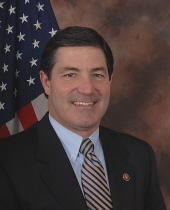The Top 50 Most Competitive U.S. House Districts in the Nation (2002-2008)
Jim Gerlach’s PA-06 seat is the only U.S. House district in the nation decided by less than 10 points in each of the last four election cycles; Democrats currently hold 35 of the Top 50 most competitive seats

Out of the 435 U.S. House elections held every other November across the United States, only one congressional district has provided a nail-biting finish without fail since new district lines went into effect in 2002.
A new Smart Politics analysis of 1,740 general election U.S. House contests since 2002 finds that the 6th Congressional District of Pennsylvania is the only district to have been decided by less than 10 points in each election cycle.
In fact, PA-06 has been decided by less than five points in each of these elections – and Republican Jim Gerlach, who has represented the district since 2003, is still standing.
Gerlach, a former Pennsylvania State Senator, first won the 6th CD in 2002, when a newly drawn Congressional map forced then 5-term Democrat Tim Holden to run in the 17th CD instead of the 6th. Gerlach won his 2002 contest by 2.8 points over Democrat Dan Wofford.
Gerlach subsequently won his 2004 race against Lois Murphy by 2.0 points, his 2006 rematch against Murphy by 1.4 points, and his 2008 race against Bob Roggio by 4.2 points – while many of Gerlach’s Northeastern GOP colleagues fell to defeat during the last two election cycles.
With an average victory margin of a scant 2.6 points across four elections, no other congressional district, let alone no other member of Congress, has endured four highly competitive elections in a row since 2002 as has Representative Gerlach.
In fact, only eight other congressional districts have been decided by less than 10 points in three of the last four election cycles: CT-02, CT-04, IN-02, IN-09, MN-06, TX-17, WA-08, and the now vacant 29th District of New York, formerly held by Eric Massa.
Only one Representative besides Gerlach has won even three elections decided by less than 10 points since 2002: Republican Dave Reichert in WA-08.
Since 2002, the average victory margin in U.S. House races has been 39.2 points. Only nine districts, including PA-06, have been decided by an average of less than 10 points over the past decade and just 69 districts have yielded an average victory margin of less than 20 points during this 4-election span.
After Gerlach and PA-06, the second most competitive district in the nation since 2002 has been the 17th District of Texas, currently held by Democrat Chet Edwards. The 17th CD was narrowly won by Democrat Charlie Stenholm by 4.0 points in 2002 before the controversial redrawing of Texas districts in 2003.
Edwards (formerly serving the 11th CD) survived in the 17th in 2004 by 3.8 points, cruised to a 17.8-point victory in 2006, and then escaped with a 3.1-point victory in 2008 over Republican Rob Curnock.

Democrat Baron Hill, now in his 5th term in office, first faced Republican Mike Sodrel in 2002, defeating him by 5.1 points to win what was then his 3rd term in Congress. Sodrel sought a rematch in 2004 and ousted Hill by 1,425 votes, or a 0.5 point margin.
Hill then sought a rematch with Sodrel in 2006, and defeated the 1-term GOPer by 4.5 points for one of 31 pick-ups for the Democratic Party that November. Sodrel challenged Hill once again for a third time in 2008, losing by 19.4 points. (Sodrel is currently seeking the Republican slot for a fifth consecutive battle with Hill in 2010).
Rounding out the Top 10 most competitive U.S. House districts since 2002 are:
· #4 (tie): NC-08. Held by Democrat Larry Kissel. District average margin of victory: 7.8 points.
· #4 (tie): NM-01. Held by Democrat Martin Heinrich. District average MoV: 7.8 points.
· #6: CO-04. Held by Democrat Betsy Markey. District average MoV: 8.5 points.
· #7: WA-08. Held by Republican Dave Reichert. District average MoV: 9.0 points.
· #8 (tie): IA-03. Held by Democrat Leonard Boswell. District average MoV: 9.6 points.
· #8 (tie): FL-13. Held by Republican Vern Buchanan. District average MoV: 9.6 points.
· #10: NV-03. Held by Democrat Dina Titus. District average MoV: 10.0 points.
The list of Congressmen and Congresswomen who populate the Top 50 most competitive districts is littered with fresh faces.
While the average length of service across the entire U.S. House is 11.2 years, the average length of service for those members of Congress serving the Top 50 most competitive districts in the country is just 4.2 years.
Eighteen members on the Top 50 list were elected in 2008 with another 16 elected in 2006. Representing very competitive districts with just 1 or 2 terms in office under their belt, means many of these Representatives are prized targets for their political opposition this November.
The only Representatives on the list with more than 10 years of service in the lower chamber on Capitol Hill are Democrats Chet Edwards (TX-17; 19 years), Leonard Boswell (IA-03; 13 years), and Dennis Moore (KS-03, 11 years).
Of the 34 members elected in the nation’s most competitive districts during the Democratic tsunamis of 2006 and 2008, just six are Republicans: Michele Bachmann (MN-06), Vern Buchanan (FL-13), Lynn Jenkins (KS-02), Leonard Lance (NJ-07), Cynthia Lummis (WY-AL), and Peter Roskam (IL-06).
Overall, just 15 of the Top 50 most competitive districts are currently held by Republicans, with 35 held by Democrats.
Republicans currently serving in the Top 50 most competitive districts are the six junior members listed above – Buchanan (#8), Bachmann (#11), Lance (#13), Jenkins (#16), Lummis (#20), and Roskam (#39) – plus Dave Reichert (WA-08, #7), Geoff Davis (KY-04, #21), Thad McCotter (MI-11, #25), Mike D. Rogers (AL-03, #28), John Kline (MN-06, #36), Charlie Dent (PA-15, #41), Scott Garrett (NJ-05, #46), and Shelley Moore Capito (WV-02, #49).
These 50 most highly competitive U.S. House districts are not evenly dispersed across the country’s 50 states, as 39 come from just 17 states:
· Connecticut (Districts 02, 04, 05) Florida (08, 13, 22), Indiana (02, 07, 09), Michigan (07, 09, 11), and Pennsylvania (06, 08, 15) have the most congressional districts in the Top 50 list.
· Twelve other states each account for two districts on the list: Arizona (01, 05), Colorado (04, 07), Iowa (02, 03), Illinois (06, 08), Kansas (02, 03), Kentucky (03, 04), Minnesota (02, 06), New Hampshire (01, 02), New Jersey (05, 07), New Mexico (01, 02), North Carolina (08, 11), and Ohio (01, 15). (New Hampshire and Iowa boast the 2nd and 3rd most competitive U.S. races statewide respectively, behind Wyoming).
· The three most populous states in the nation – California, Texas, and New York – yielded only three of the Top 50 most competitive districts (CA-11, NY-01, TX-17), despite accounting for more than 26 percent of the country’s U.S. House seats (114 seats collectively).
As documented in the first report in the series, states with the fewest number of congressional districts generally had the lowest average margins of victory in their U.S. House contests, while heavily-populated states with large numbers of districts generally yielded the least competitive races on average.
Of course, this list of the most competitive districts since 2002 does not mean each of these 50 seats will produce the 50 narrowest margins of victory in 2010. Other factors come into play in each election cycle, such as retirements, scandals, rising star challengers, and the occasional incumbent defeated in a primary election (not to mention the changing partisan winds in the political climate).
Additionally, some seats in purple districts that were uncompetitive for years when popular incumbents ran year after year are now ‘in play’ for both parties.

Coming up Wednesday at Smart Politics: the 50 least competitive congressional districts in the nation.
The 50 Most Competitive U.S. House Districts in the Nation, 2002-2008 (by average margin of victory)
|
Rank
|
District
|
Held by
|
Years
|
’02
|
’04
|
’06
|
’08
|
Ave
|
|
1
|
PA-06
|
J. Gerlach (R)
|
7.2
|
2.8
|
2.0
|
1.4
|
4.2
|
2.6
|
|
2
|
TX-17
|
C. Edwards (D)
|
19.2
|
4.0
|
3.8
|
17.8
|
3.1
|
7.2
|
|
3
|
IN-09
|
B. Hill (D)
|
9.2
|
5.1
|
0.5
|
4.5
|
19.4
|
7.4
|
|
4
|
NC-08
|
L. Kissell (D)
|
1.2
|
9.0
|
11.0
|
0.2
|
10.8
|
7.8
|
|
4
|
NM-01
|
M. Heinrich (D)
|
1.2
|
10.6
|
8.9
|
0.4
|
11.4
|
7.8
|
|
6
|
CO-04
|
B. Markey (D)
|
1.2
|
13.2
|
6.2
|
2.5
|
12.2
|
8.5
|
|
7
|
WA-08
|
D. Reichert (R)
|
5.2
|
22.5
|
4.8
|
3.0
|
5.6
|
9.0
|
|
8
|
FL-13
|
V. Buchanan (R)
|
3.2
|
9.6
|
10.6
|
0.2
|
18.0
|
9.6
|
|
8
|
IA-03
|
L. Boswell (D)
|
13.2
|
8.4
|
10.5
|
5.3
|
14.0
|
9.6
|
|
10
|
NV-03
|
D. Titus (D)
|
1.2
|
18.9
|
14.1
|
1.9
|
5.1
|
10.0
|
|
11
|
CT-04
|
J. Himes (D)
|
1.2
|
28.8
|
4.8
|
3.4
|
4.3
|
10.3
|
|
11
|
MN-06
|
M. Bachmann (R)
|
3.2
|
22.2
|
8.1
|
8.0
|
3.0
|
10.3
|
|
13
|
NJ-07
|
L. Lance (R)
|
1.2
|
17.1
|
15.2
|
1.5
|
9.2
|
10.8
|
|
14
|
IL-08
|
M. Bean (D)
|
5.2
|
14.8
|
3.4
|
6.9
|
19.8
|
11.2
|
|
15
|
OR-05
|
K. Schrader (D)
|
1.2
|
9.6
|
8.6
|
11.2
|
15.9
|
11.3
|
|
16
|
KS-02
|
L. Jenkins (R)
|
1.2
|
22.9
|
14.9
|
3.5
|
4.8
|
11.5
|
|
17
|
GA-12
|
J. Marshall (D)
|
7.2
|
10.4
|
3.6
|
0.6
|
32.0
|
11.7
|
|
17
|
KY-03
|
J. Yarmuth (D)
|
3.2
|
3.2
|
22.5
|
2.4
|
18.8
|
11.7
|
|
19
|
IA-02
|
D. Loebsack (D)
|
3.2
|
6.5
|
19.7
|
2.9
|
18.3
|
11.9
|
|
20
|
WY-AL
|
C. Lummis (R)
|
1.2
|
24.3
|
13.4
|
0.5
|
9.8
|
12.0
|
|
21
|
KY-04
|
G. Davis (R)
|
5.2
|
3.6
|
10.5
|
8.3
|
26.0
|
12.1
|
|
22
|
MI-07
|
M. Schauer (D)
|
1.2
|
21.1
|
22.1
|
3.9
|
2.3
|
12.4
|
|
23
|
AZ-01
|
A. Kirkpatrick (D)
|
1.2
|
3.6
|
21.7
|
8.4
|
16.2
|
12.5
|
|
23
|
CT-02
|
J. Courtney (D)
|
3.2
|
8.2
|
8.4
|
0.0
|
33.2
|
12.5
|
|
25
|
MI-11
|
T. McCotter (R)
|
7.2
|
17.5
|
16.0
|
11.1
|
6.0
|
12.7
|
|
26
|
CO-07
|
E. Perlmutter (D)
|
3.2
|
0.1
|
11.9
|
12.8
|
26.2
|
12.8
|
|
27
|
MI-09
|
G. Peters (D)
|
1.2
|
18.2
|
19.0
|
5.4
|
9.5
|
13.0
|
|
28
|
AL-03
|
M. Rogers (R)
|
7.2
|
2.1
|
22.5
|
20.9
|
7.0
|
13.1
|
|
29
|
PA-08
|
P. Murphy (D)
|
3.2
|
25.2
|
12.0
|
0.6
|
15.1
|
13.2
|
|
30
|
NY-01
|
T. Bishop (D)
|
7.2
|
1.6
|
12.4
|
24.4
|
16.0
|
13.6
|
|
30
|
OH-15
|
M. Kilroy (D)
|
1.2
|
33.2
|
20.0
|
0.5
|
0.7
|
13.6
|
|
32
|
NH-01
|
C. Shea-Porter (D)
|
3.2
|
19.6
|
26.7
|
2.7
|
5.9
|
13.7
|
|
33
|
NC-11
|
H. Shuler (D)
|
3.2
|
12.7
|
9.8
|
7.6
|
26.2
|
14.1
|
|
34
|
OH-01
|
S. Driehaus (D)
|
1.2
|
29.6
|
19.7
|
4.4
|
3.0
|
14.2
|
|
35
|
IN-07
|
A. Carson (D)
|
2.0
|
9.0
|
10.7
|
7.6
|
30.2
|
14.4
|
|
36
|
MN-02
|
J. Kline (R)
|
7.2
|
11.1
|
16.1
|
16.2
|
14.7
|
14.5
|
|
36
|
NH-02
|
P. Hodes (D)
|
3.2
|
15.9
|
20.1
|
7.1
|
15.0
|
14.5
|
|
38
|
IN-02
|
J. Donnelly (D)
|
3.2
|
4.7
|
9.7
|
8.0
|
36.9
|
14.8
|
|
39
|
AZ-05
|
H. Mitchell (D)
|
3.2
|
24.9
|
21.3
|
4.0
|
9.6
|
15.0
|
|
39
|
IL-06
|
P. Roskam (R)
|
3.2
|
30.2
|
11.6
|
2.8
|
15.2
|
15.0
|
|
41
|
CA-11
|
J. McNerney (D)
|
3.2
|
20.8
|
22.6
|
6.6
|
11.2
|
15.3
|
|
41
|
PA-15
|
C. Dent (R)
|
5.2
|
14.8
|
19.2
|
10.1
|
17.2
|
15.3
|
|
43
|
FL-08
|
A. Grayson (D)
|
1.2
|
30.2
|
21.0
|
7.1
|
4.0
|
15.6
|
|
43
|
KS-03
|
D. Moore (D)
|
11.2
|
3.3
|
11.5
|
31.0
|
16.5
|
15.6
|
|
43
|
UT-02
|
J. Matheson (D)
|
9.2
|
0.7
|
11.6
|
21.7
|
28.4
|
15.6
|
|
46
|
NJ-05
|
S. Garrett (R)
|
7.2
|
21.2
|
16.5
|
11.1
|
14.1
|
15.7
|
|
47
|
FL-22
|
R. Klein (D)
|
3.2
|
22.4
|
27.5
|
3.8
|
9.3
|
15.8
|
|
48
|
NM-02
|
H. Teague (D)
|
1.2
|
12.5
|
20.4
|
18.9
|
12.0
|
16.0
|
|
49
|
WV-02
|
S. Moore Capito (R)
|
9.2
|
20.0
|
16.2
|
14.4
|
14.2
|
16.2
|
|
50
|
CT-05
|
C. Murphy (D)
|
3.2
|
10.9
|
21.6
|
13.1
|
19.8
|
16.4
|
|
50
|
ID-01
|
W. Minnick (D)
|
1.2
|
19.7
|
39.0
|
5.1
|
1.6
|
16.4
|
General elections only. ‘Years’ reflects the total number of years served in the U.S. House, whether consecutively or otherwise, across all districts the member of Congress has served. Data compiled from Office of the Clerk, U.S. House of Representatives by Smart Politics.
Follow Smart Politics on Twitter.
